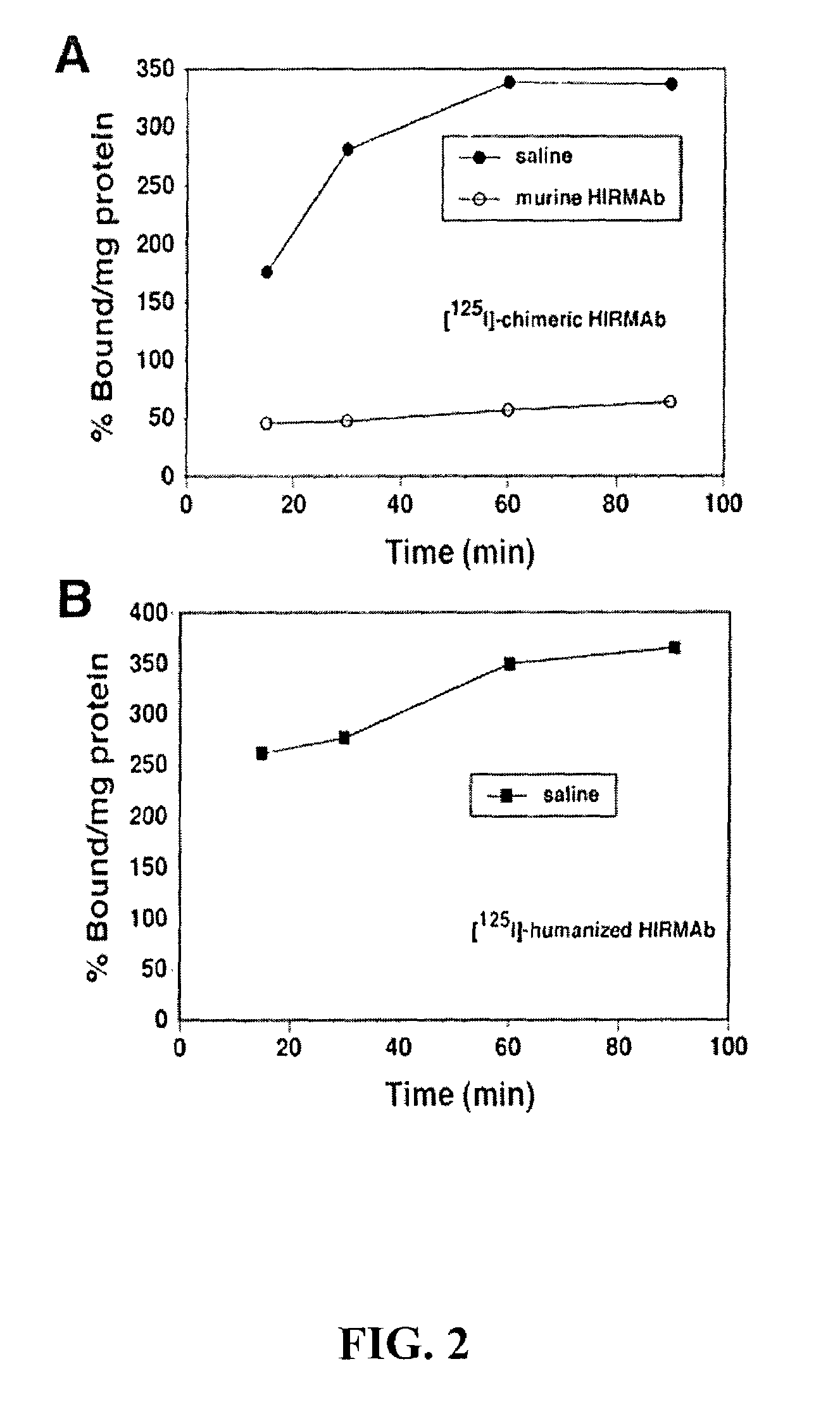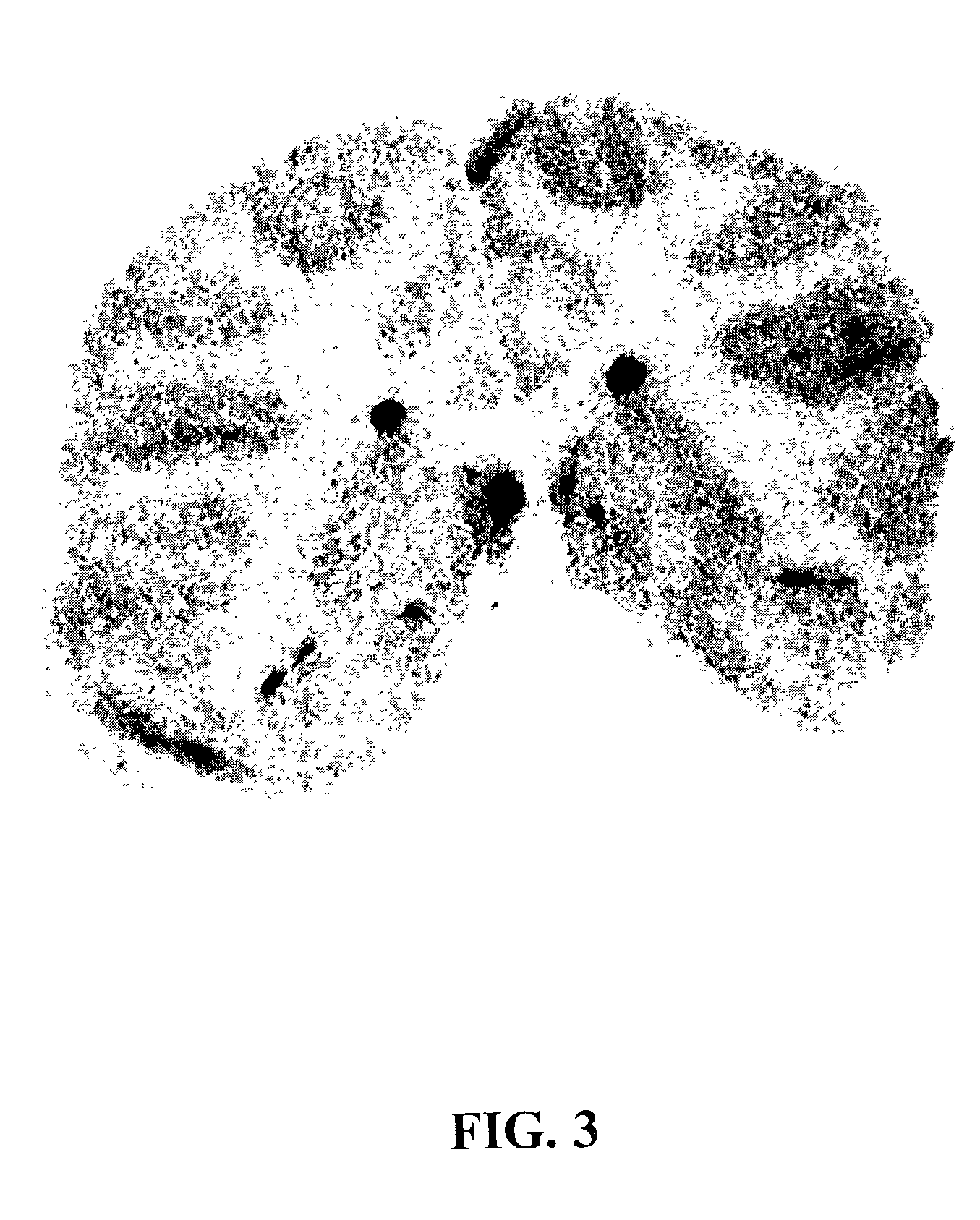Delivery of pharmaceutical agents via the human insulin receptor
a technology of insulin receptor and delivery method, which is applied in the direction of drug composition, instruments, peptides, etc., can solve the problems of ineffective delivery method of craniotomy-based drugs to the brain, inability to humanize murine hirmab with retention of biological activity, and difficult and stubborn barriers to traverse safely. , to achieve the effect of reducing immunogenic reactions
- Summary
- Abstract
- Description
- Claims
- Application Information
AI Technical Summary
Benefits of technology
Problems solved by technology
Method used
Image
Examples
example 1
Cloning of Murine 83-14 VH and VL Genes
[0044]Poly A+ RNA was isolated from the 83-14 hybridoma cell line (Soos et al, 1986), and used to produce complementary DNA (cDNA) with reverse transcriptase. The cDNA was used with polymerase chain reaction (PCR) amplification of either the 83-14 VH or 83-14 VL gene using oligodeoxynucleotide (ODN) primers that specifically amplify the VH and VL of murine antibody genes, and similar methods are well known (Li et al., 1999). The sequences of PCR ODNs suitable for PCR amplification of these gene fragments are well known (Li., 1999). The PCR products were isolated from 1% agarose gels and the expected 0.4 Kb VH and VL gene products were isolated. The VH and VL gene fragments were sequentially subcloned into a bacterial expression plasmid so as to encode a single chain Fv (ScFv) antibody. The ScFv expression plasmid was then used to transform E. Coli. Individual colonies were identified on agar plates and liquid cultures were produced in LB medium...
example 2
Iterative Humanization of the 83-14 HIRMAb: Version 1 Through Version 5
[0045]Humanization of the 83-14 MAb was performed by CDR / FR grafting wherein the mouse FRs in the 83-14 MAb are replaced by suitable human FR regions in the variable regions of both the LC and HC. The Kabat database was screened using the Match program. Either the murine 83-14 VH or the VL amino acid sequence was compared with human IgG VH or human κ light chain VL databases. Using the minimal mismatch possible, several human IgG molecules were identified that contained FR amino sequences highly homologous to the amino acid sequences of the murine 83-14 VH and VL. The framework regions of the B43 human IgG1 heavy chain and the REI human K light chain were finally selected for CDR / FR grafting of the murine 83-14 HIRMAb.
[0046]Sets of 6 ODN primers, of 69-94 nucleotides in length, were designed to amplify the synthetic humanized 83-14 VL and VH genes (Tables 1 and 2). The ODN primers overlapped 24 nucleotides in bot...
example 3
Binding of the Humanized HIRMAb to the Human BBB
[0060]Prior work has reported that the radiolabelled murine HIRMAb avidly binds to human brain capillaries with percent binding approximately 400% per mg protein at 60-120 minutes of incubation (Pardridge et al., 1995). Similar findings were recorded with radiolabelled Version 5 humanized HIRMAb in this example. When human brain capillaries were incubated in a radioreceptor assay with [125I] Version 5 humanized HIRMAb, the percent binding approximated 400% per mg protein by 60 minutes of incubation at room temperature, and approximated the binding to the human brain capillary of the [125I-chimeric HIRMAb (see FIGS. 2A and 2B). In contrast, the binding of a nonspecific IgG to human brain capillaries is less than 5% per mg protein during a comparable incubation period Pardridge et al., 1995). This example shows that the Version 5 humanized HIRMAb was avidly bound and endocytosed by the human brain capillary, which forms the BBB in vivo.
PUM
| Property | Measurement | Unit |
|---|---|---|
| melting point | aaaaa | aaaaa |
| melting point | aaaaa | aaaaa |
| volume | aaaaa | aaaaa |
Abstract
Description
Claims
Application Information
 Login to View More
Login to View More - R&D
- Intellectual Property
- Life Sciences
- Materials
- Tech Scout
- Unparalleled Data Quality
- Higher Quality Content
- 60% Fewer Hallucinations
Browse by: Latest US Patents, China's latest patents, Technical Efficacy Thesaurus, Application Domain, Technology Topic, Popular Technical Reports.
© 2025 PatSnap. All rights reserved.Legal|Privacy policy|Modern Slavery Act Transparency Statement|Sitemap|About US| Contact US: help@patsnap.com



